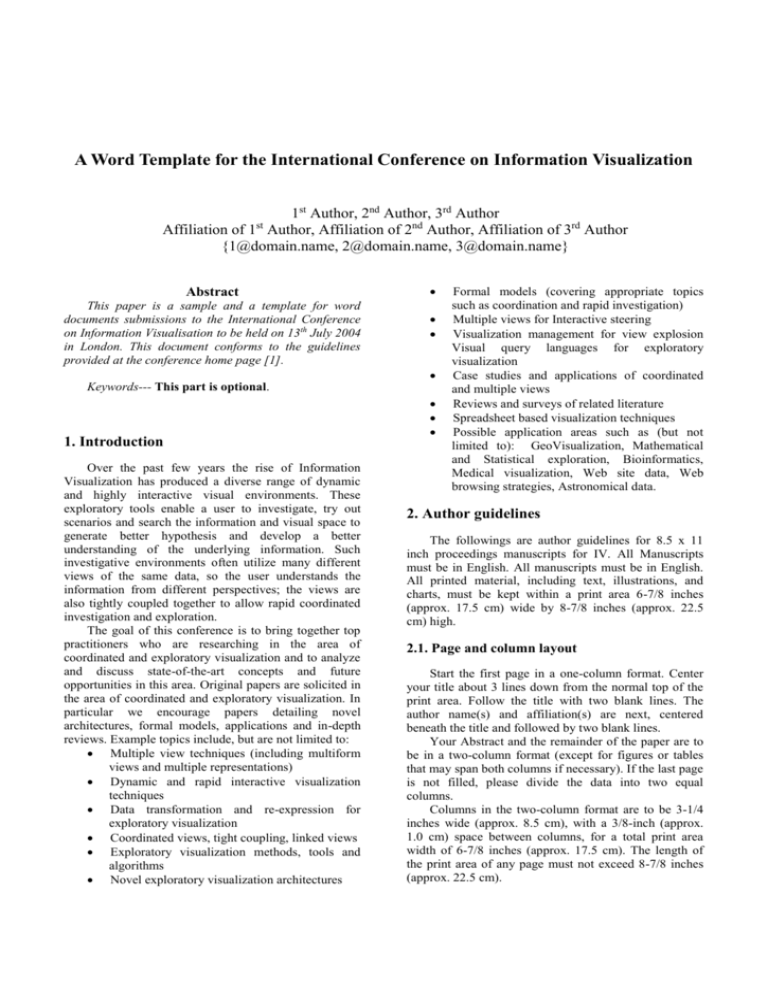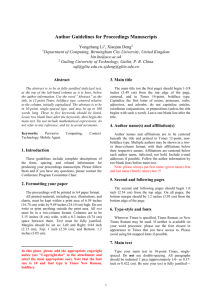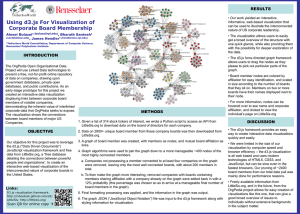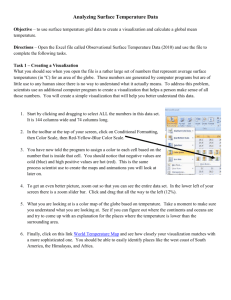IV16 Paper Format
advertisement

A Word Template for the International Conference on Information Visualization
1st Author, 2nd Author, 3rd Author
Affiliation of 1 Author, Affiliation of 2nd Author, Affiliation of 3rd Author
{1@domain.name, 2@domain.name, 3@domain.name}
st
Abstract
This paper is a sample and a template for word
documents submissions to the International Conference
on Information Visualisation to be held on 13th July 2004
in London. This document conforms to the guidelines
provided at the conference home page [1].
Keywords--- This part is optional.
1. Introduction
Over the past few years the rise of Information
Visualization has produced a diverse range of dynamic
and highly interactive visual environments. These
exploratory tools enable a user to investigate, try out
scenarios and search the information and visual space to
generate better hypothesis and develop a better
understanding of the underlying information. Such
investigative environments often utilize many different
views of the same data, so the user understands the
information from different perspectives; the views are
also tightly coupled together to allow rapid coordinated
investigation and exploration.
The goal of this conference is to bring together top
practitioners who are researching in the area of
coordinated and exploratory visualization and to analyze
and discuss state-of-the-art concepts and future
opportunities in this area. Original papers are solicited in
the area of coordinated and exploratory visualization. In
particular we encourage papers detailing novel
architectures, formal models, applications and in-depth
reviews. Example topics include, but are not limited to:
Multiple view techniques (including multiform
views and multiple representations)
Dynamic and rapid interactive visualization
techniques
Data transformation and re-expression for
exploratory visualization
Coordinated views, tight coupling, linked views
Exploratory visualization methods, tools and
algorithms
Novel exploratory visualization architectures
Formal models (covering appropriate topics
such as coordination and rapid investigation)
Multiple views for Interactive steering
Visualization management for view explosion
Visual query languages for exploratory
visualization
Case studies and applications of coordinated
and multiple views
Reviews and surveys of related literature
Spreadsheet based visualization techniques
Possible application areas such as (but not
limited to): GeoVisualization, Mathematical
and Statistical exploration, Bioinformatics,
Medical visualization, Web site data, Web
browsing strategies, Astronomical data.
2. Author guidelines
The followings are author guidelines for 8.5 x 11
inch proceedings manuscripts for IV. All Manuscripts
must be in English. All manuscripts must be in English.
All printed material, including text, illustrations, and
charts, must be kept within a print area 6-7/8 inches
(approx. 17.5 cm) wide by 8-7/8 inches (approx. 22.5
cm) high.
2.1. Page and column layout
Start the first page in a one-column format. Center
your title about 3 lines down from the normal top of the
print area. Follow the title with two blank lines. The
author name(s) and affiliation(s) are next, centered
beneath the title and followed by two blank lines.
Your Abstract and the remainder of the paper are to
be in a two-column format (except for figures or tables
that may span both columns if necessary). If the last page
is not filled, please divide the data into two equal
columns.
Columns in the two-column format are to be 3-1/4
inches wide (approx. 8.5 cm), with a 3/8-inch (approx.
1.0 cm) space between columns, for a total print area
width of 6-7/8 inches (approx. 17.5 cm). The length of
the print area of any page must not exceed 8-7/8 inches
(approx. 22.5 cm).
2.2. Abstracts
place in the article. If you are printing a hard copy, use
rubber cement to affix the artwork in place.
The Abstract should be approximately 150 words or
fewer, italicized, in 10-point Times (or Times Roman.)
Please leave two spaces between the Abstract and the
heading of your first section.
2.3. Type style and size of text
Normal text is to be single spaced in 10-point Times
or Times Roman (or similar font), with 12-point interline
spacing, in the two-column format. The first line of each
paragraph is to be indented approximately 1/4 inch
(approx. 0.7 cm), and the entire text is to be justified -that is, flush left and flush right. Please do not place
additional line spacing between paragraphs. Figure and
table captions should be Helvetica 10-point boldface;
callouts should be Helvetica 9-point nonboldface.
Figure 1 CMV2004 Logo
Although halftones can be shot from color prints,
black and white photos are preferable. Please supply the
best quality photographs and illustrations possible. The
quality of the book cannot be better than
the originals provided.
2.6. Use of tape (for hard copy)
2.4. Title and headings
The main title should be in Times (or Times Roman)
14-point boldface centered over both columns. In the
main title, please initially capitalize nouns, pronouns,
verbs, adjectives, and adverbs; do not capitalize articles,
coordinate conjunctions, and prepositions (unless the title
begins with such a word). Initially capitalize only the
first word in first-, second-, and third-order headings.
Leave
two
blank
lines
before
author
names(s)/affiliation(s).
2.4.1. Author Name(s)/Affiliation(s) are to be
centered in Times (or Times Roman) 12-point
nonboldface. Leave two blank lines before your Abstract.
2.4.2. Abstract heading The abstract heading is to
be 11-point boldface, initially capitalized and centered
within the column.
2.4.3. First-order headings (for example, 1.
Introduction) are to be Times 12-point boldface, flush
left, with one blank line before, and one blank line after.
2.3.4. Second-order headings (for example, 2.1:
Page and column layout) are to be Times 11-point
boldface, flush left, with one blank line before, and one
after. If you require a third-order heading (we discourage
it), then it is to be in Times 10-point boldface, preceded
by one blank line, and followed by a period and text on
same line.
2.5. Illustrations, graphs and photographs
Do not place cellophane tape over any part of your
text or graphics. (Cellophane tape may distort or
obliterate what it covers, and it retains fingerprints and
dirt smudges.)
2.7. Use of color
The use of color on interior pages (that is, pages
other than the cover) is prohibitively expensive.
Consequently, we publish interior pages in color only
when it is specifically requested and budgeted for by the
conference organizers. If these proceedings are going to
have color photos, you must provide a clearly marked
slide with its corresponding plate number, your name,
and the position of the slide (if there is more than one).
You also need to identify the right side and the top of the
slide. Please make a Xerox copy (or photocopy) of each
photo (or a small, rough sketch) and attach it with rubber
cement to show the intended size and location. Color
photos are sent to a color separator before going to the
printer, so it is essential that we have this information to
ensure the correct display of your color graphics.
2.8. Footnotes
Use footnotes sparingly and place them at the
bottom of the column in which they are referenced (not
full width across two columns). Use Times 8-point type
with 10-point interline spacing for footnotes. To help
readers, avoid footnotes altogether and include necessary
peripheral observations in your text (within parentheses,
if you prefer, as in this sentence).
Illustrations, graphs, and photographs may fit across
both columns, if necessary. Your artwork must be in
2.9. References List
List and number all bibliographical references at the
end of your paper in 9-point Times, with 10-point
interline spacing. When referenced within the text,
enclose the citation number in square brackets, for
example [2] for a conference paper reference and [3] for
a book reference. Since this will be the end of your
paper, if the last page is not filled, please divide the data
into two equal columns.
Acknowledgements 1
CMV 2004 is associated with the International
Conference on Information Visualization IVO4.
2.10. Printing your paper (for hard-copy)
Print your properly formatted text on high-quality,
8.5 x 11-inch white printer paper (A4 size is also
acceptable). All printed material, including text,
illustrations, and charts, must be kept within a print area
6-7/8 inches (approx. 17.5 cm) wide by 8-7/8 inches
(approx. 22.5 cm) high.
References
[1]
[2]
[3]
CMV2004 url: http://www.cvev.org/cmv2004/index.html
E.R. Tufte. Envisioning Information. Cheshire, CT,
Graphics Press. 1990.
Jonathan Roberts, Nadia Boukhelifa and Peter Rodgers.
Multiform Glyph Based Search Result Visualization. In
Proceeding Information Visualization 2002. IVS, IEEE,
549-554. July 2002.
Conclusions
We described the formatting instructions for the
CMV proceedings. Please, try to fix the format of your
contribution as close as possible if you use other tools.
1
The acknowledgment section is optional.







